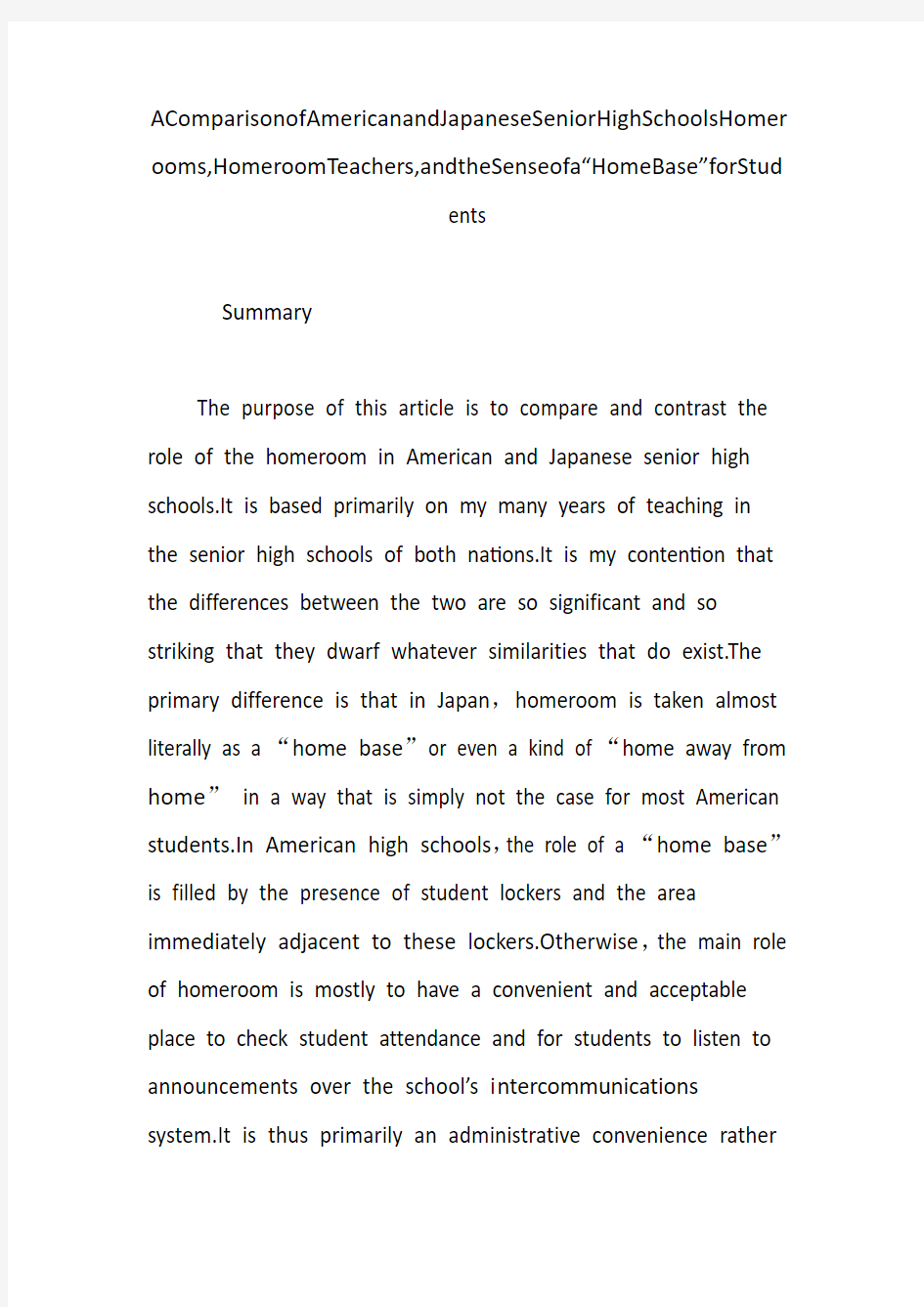AComparisonofAmericanandJapaneseSeniorHighSchoolsHomerooms,HomeroomTeachers,andtheSenseofa“HomeBase


AComparisonofAmericanandJapaneseSeniorHighSchoolsHomer ooms,HomeroomTeachers,andtheSenseofa“HomeBase”forStud
ents
Summary
The purpose of this article is to compare and contrast the role of the homeroom in American and Japanese senior high schools.It is based primarily on my many years of teaching in the senior high schools of both nations.It is my contention that the differences between the two are so significant and so striking that they dwarf whatever similarities that do exist.The primary difference is that in Japan,homeroom is taken almost literally as a “home base”or even a kind of “home away from home”in a way that is simply not the case for most American students.In American high schools,the role of a “home base”is filled by the presence of student lockers and the area immediately adjacent to these lockers.Otherwise,the main role of homeroom is mostly to have a convenient and acceptable place to check student attendance and for students to listen to announcements over the school’s i ntercommunications system.It is thus primarily an administrative convenience rather
than a major educational or social institution.
In the following article I shall examine what is referred to as the homeroom in both American and Japanese senior high schools.My main purpose is to highlight the often striking differences in both the concept and everyday reality of the homeroom and how these differences play themselves out in the secondary school systems of each nation.Before beginning this task a quick word of explanation about the form of this essay is in order.Previously I have written several articles that relied upon extensive use of secondary as well as primary sources.But in this essay I have resisted this impulse in order to rely mostly on my own primary research,namely,my own experiences in both American and Japanese high schools,first as a high school student and later as a full-time teacher.Any researcher interested in the core literature on this topic should consult the various sources listed in the References section included at the end of this essay.
An American homeroom teacher’s primary responsibility is to ensure two things:one,that students arrive at school on time in the morning,and two,that the number of student absences is kept to a minimum.These are the teacher’s two most explicit formal tasks.In addition to this,the teacher should
also ensure that students come to school properly dressed,that they are in good health,and that they are generally prepared for that day’s classes.However,other than these formal duties,homeroom teachers are fairly limited in their formal roles and responsibilities.Generally speaking,modern public and private American high schools hire an array of specialists who are ready to take on the specialized needs and troubles of students.For example,if a homeroom teacher notices that a student is upset or crying excessively,he or she may try to comfort or advise that student.However,if the problem persists,that same homeroom teacher will simply refer that student to the school psychologist.At I.H.high school,a professional psychologist was employed to deal with such matters.This psychologist held a doctorate in adolescent psychology and was very experienced
in advising and counseling troubled teenage students.
The same situation existed in terms of older students who were trying to decide which colleges to apply to.The homeroom teacher might try to give some informal advice based on his or her own collegiate experiences,but the teacher would ultimately refer such a student to the school’s full-time guidance counselor for detailed help and information.This counselor had an office to himself and could give students
plenty of information about colleges and universities,including information that the student’s homeroom teacher simply would not have knowledge of or easy access to.And if a student is having serious problems in terms of discipline,absences,or lateness,the chances are that the homeroom teacher would simply refer the student to the administrator responsible for dealing with student behavior.At I.H.,this person would be either the dean of students or the vice-principal.
I hope that my discussion of the role of homerooms and homeroom teachers in American and Japanese senior high schools will prove helpful.It is intended for professional researchers,teachers abroad who are interested in teaching in Japan,as well as people with a general interest in the topic of comparative education.
References:
[1]Baris-Sanders,Marcia.“Cooperative Education:Lessons from Japan.”Phi Delta Kappan 78.8 (April 1997).
[2]Eracey,Gerald W.“Asian and American Schools Again.”Phi Delta Kappan 77.9 (May 1996).
[3]Cummings,William K.Rev.of Japan’s‘International Youth’:The Emergence of a New Class of School Children,by Roger Goodman.American Journal of Sociology 97.6 (May
1992).
